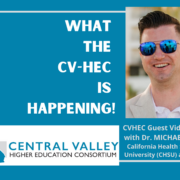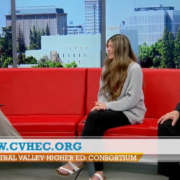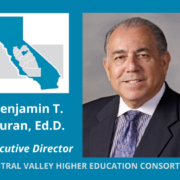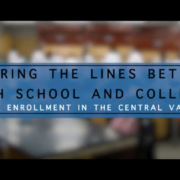CV-HEC VLOG – August 2022: Dr. Mike Farr, CHSU Alumnus
 This month’s “What The CV-HEC Is Happening” Blog features a guest vlog with Dr. Mike Farr, an alumnus of CVHEC-member California Health Science University when he was featured on GVWire’s “Unfiltered” weekly virtual talk show May 24 hosted by Darius Assemi, president of Granville Homes in Fresno.
This month’s “What The CV-HEC Is Happening” Blog features a guest vlog with Dr. Mike Farr, an alumnus of CVHEC-member California Health Science University when he was featured on GVWire’s “Unfiltered” weekly virtual talk show May 24 hosted by Darius Assemi, president of Granville Homes in Fresno.
Dr. Farr shared his experience as one of the first medical students in the CHSU leading to his career in two positions presently: as a retail pharmacist for Walgreen’s and as a clinical pharmacist for Integrated Prescription Management. He served as CSHU student body president and was conferred the Doctor of Pharmacy (PharmD) degree with 62 graduates at CHSU’s first Graduation Ceremony May 19, 2018. Dr. Farr touts the value of having a medical school in the Central Valley.
(Note: the show was the second part that followed a debate featuring two Fresno County sheriff candidates in the June election).
Presenting our renovated CVHEC Website: Meet our Board of Directors
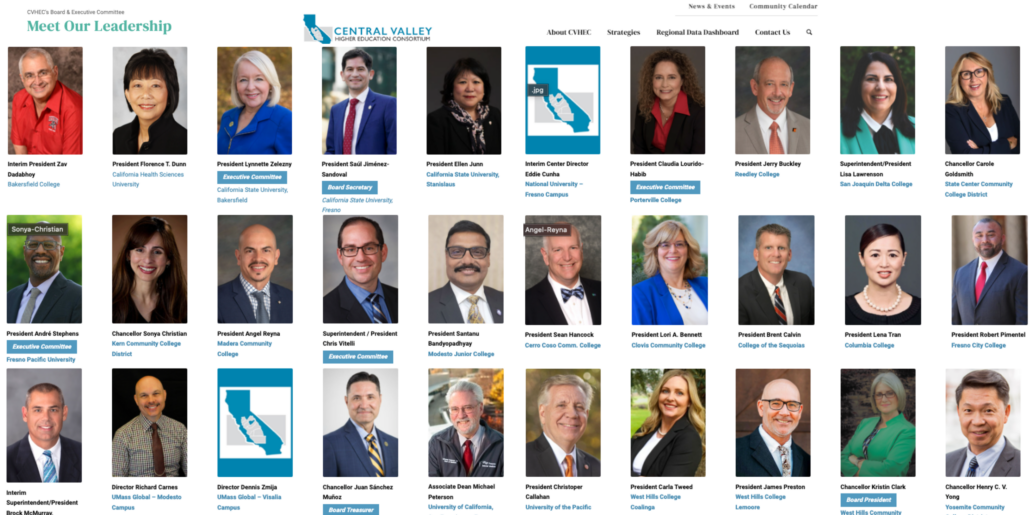
The chancellors, presidents and superintendents of 30 institutions of higher education in the Central Valley nine-county region from Stockton to Bakersfield sit on the CVHEC Board of Directors. They meet quarterly in pursuit of CVHEC’s core mission to increase valley college-going rates and degree/certification attainment, providing a unified voice for their more than 250,000 students served jointly. See the board of directors section in our newly renovated website: https://cvhec.org/about-cvhec/
This fall, we unveil phase one of our renovated Central Valley Higher Education Consortium website which we hope will be easier to navigate as we showcase the work of the Consortium throughout the valley.
We will be featuring a different piece of our website as we continue to build it out in hopes of showcasing it as a resource for our members, colleagues and partners.
This month, we feature the professionals and experts who are carrying out the CVHEC mission. On the “About CVHEC” page, you can meet our CVHEC Board of Directors – the presidents and chancellors of our 30 members of higher education in the Central Valley’s nine-county region from Stockton to Bakersfield as well as the core staff that includes several former educational leaders who now served as CVHEC regional coordinators/liasions,
Also, see our CVHEC News web page that is being finalized this fall featuring our newsletter stories and press releases where news media can connect with us as well as the members of our CVHEC PIO/Communicators Committee, consisting of the communications professionals handling media relations at each of the 30 campuses.
Our new calendar will keep you up-to-date on CVHEC and other higher education events on our radar. For considerations and modifications to our calendar please email centralvalleyhec@gmail.com.
CVHEC in the News: KSEE Central Valley Today Features Dual Enrollment
CVHEC’s dual enrollment measures were featured on KSEE-TV24’s Central Valley Today Program. Host Emily Erwin interviewed CHEC Executive Director Benjamin Duran and Nataly Frias, an alumnus of dual enrollment in Turlock and Merced College where she earned two associate degrees prior to high school graduation. Nataly is now a Fresno State junior majoring in psychology with an eye on the Nursing Program.
Watch the interview below.
CVHEC Director’s Message: Overcoming the Pandemic for CVHEC Dual Enrollment Successes
Greetings colleagues,
What an extraordinary kick off to spring 2022 we have seen in the past week.
For the first time in two years, the Central Valley Higher Education Consortium and its partners came together in what one participant described as “a unique space where K-12 educators teamed up with higher education officials” during our Dual Enrollment Convening March 17 in downtown Fresno.
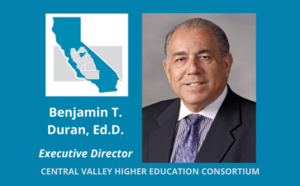 This convening accomplished many objectives, but one is for certain: we did not let the pandemic of the past two years get us down.
This convening accomplished many objectives, but one is for certain: we did not let the pandemic of the past two years get us down.
Not only did we reflect on the progress we accomplished via virtual existence the past 24 months but we also presented that story through our newest video premiered at the convening and which we reveal publicly in this issue of our e-newsletter – “Blurring the Lines Between High School and College: Dual Enrollment in the Central Valley.”
This video captures the success story of three Central Valley students who have made the most of the dual enrollment opportunity afforded to them: Nataly Frias of Turlock High School; Isaac Bates of Corcoran High; and Alicia Bias of Washington Union High in partnership with CVHEC members Merced College, College of the Sequoias and Fresno City College respectively. They are representative of the outstanding Central Valley students enrolled in dual enrollment college courses while in high school
It also features the advocacy of three dual enrollment champions: West Hills Community College Chancellor Kristen Clark; Merced College Pres Chris Vitelli; and McKenna Salazar, career engagement specialist for the Tulare County Office of Education – all articulating the value of dual enrollment for both the students and the campuses while helping close the equity gap.
And this was the spirit in force at the convening last week, aptly entitled “Establishing Dual Enrollment Pathways in the Central Valley.”
Nearly 140 educators assembled for three morning panels and three afternoon workshops to address challenges and barriers to dual enrollment success as well as review best practices with an eye on future strategies.
We are grateful to Dr. Mayra A. Lara, associate director of Educator Engagement for The Education Trust-West based in Oakland, for her presentation of her organization’s recent report, “Jumpstart California: A Roadmap for Equitable Dual Enrollment Policy & Practice.” We are happy to have them join us as our newest partners.
Overall, we heard discussion and recommendations for such topics as Advanced Placement v. dual enrollment, weighted GPAs and aligning guided pathways with high school curriculum among other relevant issues.
We plan to have a full report on the convening’s outcomes in April that will lay the groundwork for our task force to continue its trajectory as leaders in dual enrollment.
But perhaps the highlight of the event was the inspiring student panel where the three aforementioned students featured in the video joined us along with a fourth panelist, Arlene Rocha, an alumna of Wonderful Prep Academy and Bakersfield College now completing master’s work at Fresno State and Emerson online.
The students elaborated on their individual dual enrollment experiences before fielding questions from the audience, showing a level of competence and professionalism to marvel. As our student participants, they represented why we do this sometimes overwhelming but satisfying educational work. I’m sure you all came away as satisfied as I was in seeing that our efforts have the concrete results these students demonstrate.
Equally commendable are all 136 convening participants who continued the CVHEC reputation for putting action into words: all the talking, research, and analyses – while important and must continue – is irrelevant if we do not commit and execute meaningful measures as this group has done in recent years and has pledged to continue in the coming months.
Just as important, if not more so, this second convening demonstrated that our dual enrollment practitioners not only develop local solutions for a collaborative regional approach, but we also lead the way in advocating for state-level policy changes and investment for broader, systemic impact.
What the “CV-HEC” am I talking about? As we reviewed at last week’s convening, concrete results that came from our Zoom adventures of the past two years were:
- Improvements in the CCCApply application process to the California Community College system. Our CVDEEP Task Force led the way in a statewide user group with the CCC Chancellor’s Office to redesign the application for student friendliness. While work continues on these improvements, we commend the chancellor’s team for listening to our dual enrollment advocates and acting expeditiously. The task force has established a promising road for solid results.
- The Dual Enrollment Upskilling Teachers Master’s Program that provides access to state funding through the Fresno K-16 Collaborative. This initiative provides funds for high school English and math teachers to earn a master’s degree required for teaching college courses at their high school campus. We were especially pleased to see the examples of the accompanying mentor program in one of the convening panels.
So perhaps the real victory in all this is the undeniable demonstration by members of our CVDEEP Task Force — with CVHEC member community colleges and K-16 partners — rising to the challenges they imposed on themselves at the first convening in 2020; identifying potential solutions; and collaborating relentlessly for these two concrete measures that help expand dual enrollment opportunities in the region.
And all this is only the tip of the iceberg. Wait until you see what we have planned for the upcoming CVHEC Legislative and Policy Summit May 5-6 when a historic occasion is revisited: the presidents and chancellors of the region’s 29 higher ed institutions convening to address issues relevant to pursuing our goal of improving the degree and certificate attainment rate for valley residents.
Nowhere else in the nation does a region’s higher education chief executives convene in the same room for a common cause. Keep an eye out for details in our next newsletter (and be sure to register for the summit by the April 29 deadline).
To all of you partnering with us in these endeavors – thank you. This is not about one organization. It’s about you and your collaborative efforts to serve students. This is YOUR consortium.
I hope you enjoy CVHEC’s new dual enrollment video. We encourage you to use it as you see fit in telling our dual enrollment success stories and advocating for improvements. We look ahead to continuing our partnerships with each and every one of you.
Dual Enrollment Convening: Face-To-Face Space for K-12 and Higher Ed
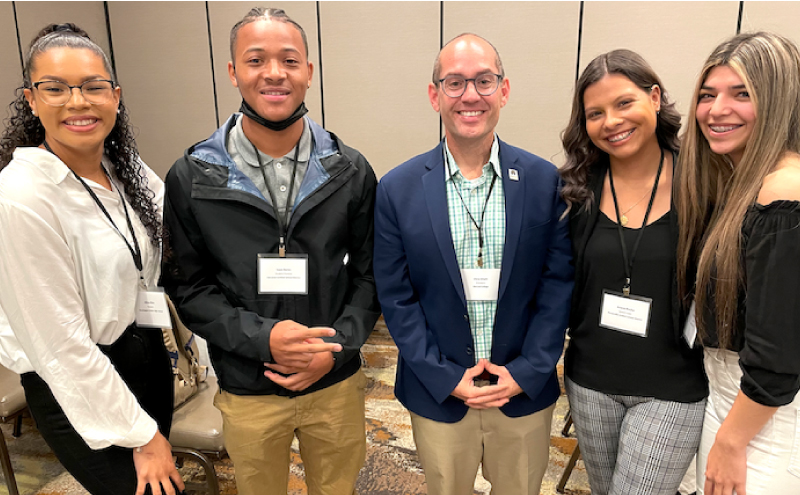
Four valley students shared their dual enrollment success stories at the “Establishing Dual Enrollment Pathways in the Central Valley” Convening during a panel moderated by Merced College President Chris Vitelli, a CVHEC board member (center): Alicia Bias, Isaac Bates, Arlene Rocha and Nataly Frias.
CVHEC premieres new video at CVDEEP convening
‘Blurring the Lines Between High School and College:
Dual Enrollment in the Central Valley’
BY TOM URIBES
CVHEC Media/Communications Coordinator
More than 135 secondary and postsecondary educators assembled for the “Establishing Dual Enrollment Pathways in the Central Valley” Convening in downtown Fresno March 17 to address challenges and barriers to dual enrollment success.
They also heard four valley students share their success stories – including two who completed associate degrees before their high school graduation.
Presented by the Central Valley Higher Education Consortium and its Central Valley Dual Enrollment for Equity and Prosperity (CVDEEP) Task Force, the five-hour convening at the DoubleTree By Hilton Hotel also featured the premiere of CVHEC’s latest education video, “Blurring the Lines Between High School and College: Dual Enrollment in the Central Valley.” (See related story this issue).
Dr. Mayra A. Lara, associate director of Educator Engagement for The Education Trust-West based in Oakland, discussed her organization’s recent report, “Jumpstart California: A Roadmap for Equitable Dual Enrollment Policy & Practice.”
While many concrete and soul-searching discussions arose from three morning sessions and three afternoon sessions, the highlight of the event was the panel of four students discussing their dual enrollment experience:
- Arlene Rocha, who earned an associate degree from Bakersfield College at age 17 while attending Wonderful Prep Academy in Delano before earning a bachelor’s degree at Fresno State by age 19, is now enrolled in the Emerson College Master’s Program online as well as the Speech Language Pathology Assistants Certification Program at Fresno State. She mapped out a rigorous and challenging — but “fun” — dual enrollment program for all four years of high school that led to 375 credits (250 required for graduation) and a 4.18 GPA.
- Nataly Frias, who earned two associate degrees from Merced College at age 18 while at Turlock High School and is now enrolled in upper-division courses for a degree in psychology at Fresno State. She said more schools should promote dual enrollment and ensure college credit is given;
- Isaac Bates, a Corcoran High School senior currently enrolled in dual enrollment courses from College of the Sequoias, said he was able to get college credit for his dual enrollment classes while his friends in Advanced Placement did not;
- Alicia Bias, a Washington Union High School senior taking Fresno City College courses where she is completing clinical labs for a medical assisting certification.
Nataly was accompanied by her parents Anthony Frias, who is a counselor at Modesto Junior College, and Sabrina Frias, a counselor at Merced College. Alicia’s mother Valerie Saenz accompanied her. All were welcomed warmly by the educators in attendance.
CVHEC Executive Director Benjamín Durán said “perhaps the highlight of the event was the inspiring student panel where the students elaborated on their individual dual enrollment experiences before fielding questions from the audience, showing a level of competence and professionalism to marvel.
“As our student participants, they represented why we do this sometimes overwhelming but satisfying educational work,” Durán said. “It was very satisfying to see that our efforts have the concrete results these students demonstrate.”
He also commended all 136 convening participants “who continued the CVHEC reputation for putting action into words.
“All the talking, research, and analyses – while important and must continue – are irrelevant if we do not commit and execute meaningful measures as this group has done in recent years and has pledged to continue in the coming months.”
Durán added that this second “annual” convening “demonstrated that our dual enrollment practitioners not only develop local solutions for a collaborative regional approach, but we also lead the way in advocating for state-level policy changes and investment for broader, systemic impact.”
In his opening remarks at the convening, Durán reviewed concrete results that were recommended at the first CVDEEP gathering in 2020 and progress in the two years since:
- Improvements in the CCCApply application process to the California Community College system.
“Our CVDEEP Task Force led the way statewide in collaborating with the CCC Chancellor’s Office to redesign the application for student friendliness,” he noted. “While work continues on these improvements, we commend the chancellor’s team for listening to our dual enrollment advocates and acting expeditiously. The task force has established a promising road for solid results.”
- The Dual Enrollment Upskilling Teachers Master’s Program that provides access to state funding through the Fresno K-16 Collaborative for high school English and math teachers to earn a master’s degree required for teaching college courses at their high school campus.
“We were especially pleased to see the examples of the accompanying master’s Mentor Program in one of the convening panels,” Durán said.
“The real victory in all this is the undeniable demonstration by members of our CVDEEP Task Force — with CVHEC member community colleges and K-16 partners — rising to the challenges they imposed on themselves at the first convening in 2020; identifying potential solutions; and collaborating relentlessly for these two concrete measures that help expand dual enrollment opportunities in the region,” he added.
“And a wonderful by-product from these interactions is that we are all learning from each other here in the Central Valley.”
Martín Macías, superintendent of Golden Plains Unified School District in San Joaquin who spoke on the panel “Meaningful Dual Enrollment Pathways in the Central Valley,” commended the task force because the convening “facilitated ways to provide access to the students with the greatest needs (our valley) and by helping us come to the table and share practices that are providing positive results systemically.”
A full report detailing recommendations from the sessions will be forthcoming in April.
See related links:
CVDEEP Convening event website
Full press release announcing the convening
BACKGROUND
In 2016, a new dual enrollment option was introduced through Assembly Bill (AB) 288, amending Education Code (EC) 76004, and creating the College and Career Access Pathways (CCAP). This legislation enabled more high school students to take college courses taught by college professors on their high school campuses. California AB 30, signed by Governor Newsome in October 2019, expands and protects dual enrollment through 2027.
New CVHEC Video: ‘Blurring the Lines Between High School and College: Dual Enrollment in the Central Valley’
The Central Valley Higher Education Consortium released its latest education video this week, “Blurring the Lines Between High School and College: Dual Enrollment in the Central Valley.”
The five-minute video, which premiered publicly at CVHEC’s Dual Enrollment Convening March 17, depicts three student success stories as well as three area educators advocating for dual enrollment. It highlights the need for intersegmental collaboration in providing dual enrollment opportunities for all students as a way not only to help students get a jumpstart on their college education – saving costs and time – but also to help close the equity gap.
The video presents Dr. Kristin Clark, chancellor of the West Hills Community College District and chair of the CVHEC board of directors; Dr. Chris Vitelli, president/superintendent of Merced College; and McKenna Salazar, college and career engagement specialist for the Tulare County Office of Education.
Three students featured included one, Nataly Frias, who earned an associate degree from Merced College last May at age 18 a few weeks before receiving her Turlock High School diploma and is now enrolled in upper-division courses for a degree in psychology at Fresno State. Nataly was also featured in the CVHEC e-newsletter in September.
The other two students are currently enrolled in high school and shared their experience with dual enrollment as they learn the challenges and benefits of college courses: Isaac Bates, a Corcoran High School senior taking dual enrollment courses from College of the Sequoias; and Alicia Bias, a Washington Union High School senior taking Fresno City College courses where she is completing clinical labs for a medical assisting certification.
The three also made a live appearance at last week’s CVDEEP convening serving on the student panel sharing their experiences, moderated by President Vitelli.
CVHEC Executive Director Benjamín Durán said this video articulates the value of dual enrollment for both the students and the campuses while helping close the equity gap.
“The video portrays the success story of three Central Valley students who have made the most of the dual enrollment opportunity afforded to them,” Duran said. “They represent why we do this sometimes overwhelming but satisfying educational work and it’s satisfying seeing that our efforts have the concrete results these students demonstrate.”
He said the CVHEC video is available for use by anyone who wishes to help promote the value of dual enrollment: https://bit.ly/CVHECeNewsMARCH22.
The video project was coordinated by Tom Uribes, CVHEC media and communications specialist and retired Fresno State public information officer, and produced by the Fenceline Media crew of Fresno area journalists Juanita Stephenson and Justin Davis.


